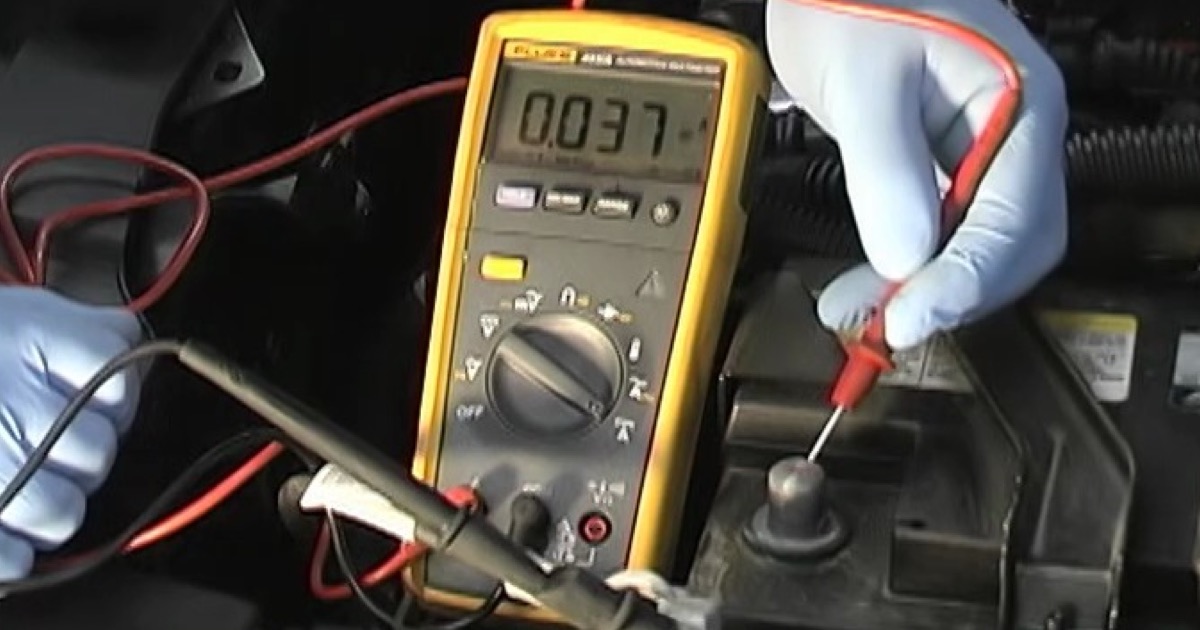Looking for a quick way to test parasitic draw?
With today’s vehicles having electronic modules that stay awake for extended periods of time, it can be time consuming waiting for them to go back to sleep after connecting an ammeter when you measure the parasitic draw.
Here is a very different way of testing for excessive draw that doesn’t require you to disconnect one of the battery terminals, or measure the mV drop across multitudes of fuses. It is very quick to do, and will allow you to immediately determine if an excessive draw is present. It is a bit controversial, but I think you will find it can save a lot of time and requires no special tools other than a DVOM.
It is named the Chesney parasitic draw test after its creator, Sean Chesney. Instead of using an ammeter to measure the draw, an ohmmeter is used.
The first thing to do is measure the test leads “delta” (resistance above zero). Set the ohmmeter to ohms (the lowest scale), touch the meter leads together, and read the screen. The reading is the resistance of the meter leads and is the meter’s true zero when used with those leads. Typically, an ohmmeter will read about 0.1 ohms when the leads are touched together. Some meters have a delta feature that recalibrates the ohmmeter to zero when the leads are placed together and the delta button is pushed. If your meter has this delta feature, you can use it so that you will not have to remember the delta reading. But for now, let’s say your meter reads 0.2 ohms delta.
Next, with the battery terminals still connected to the battery, place the DVOM’s black lead on the negative post of the battery and the red lead on an unpainted surface of the alternator housing. Read the ohmmeter and subtract the delta value from the reading. This reading corresponds to the relative parasitic draw on the system. For example, if the DVOM now reads 0.9 ohms, subtract the original 0.2 ohms reading of the leads. This leaves a reading of 0.7 ohms delta.
Through testing, Chesney found that a draw of about 35 milliamps equaled an ohm reading of about 0.3 ohms delta (above the delta value) on a DVOM with 10 megohms of impedance, and about 0.6 ohms delta on a DVOM with 20 megohms of impedance. Anything above those readings indicates an excessive parasitic draw. So in our example of 0.7 ohms delta, and a 10 megohm meter, the parasitic load is approximately 90 milliamps, which is well above the standard 35 milliamp limit, indicating an excessive parasitic draw.
If you are skeptical of this method like I was, go out and try it on several vehicles. Simulate a parasitic draw by opening the driver’s door (make sure the dome light illuminates), and watch the ohmmeter reading. It went up substantially, right?
Next, close the door. As soon as the light goes off, the ohmmeter reading goes back down, right? If you use this test and find an excessive draw, pull fuses one at a time, watching for the ohmmeter reading to decrease. If it does not decrease after removing all of the fuses, suspect an unfused circuit such as the alternator diodes or the ignition circuit on some vehicles.
Now you have a quick, handy test for identifying excessive parasitic draws that requires no wasted time waiting for modules to time out!
Want to teach your students this quick method to test parasitic draw?
The all-new second edition of Fundamentals of Automotive Maintenance & Light Repair includes step-by-step instruction on this and other quick, reliable tricks that work in the shop.
